Complete Guide to Surface Finish Charts, RA, RZ, Measurements, Callouts and Symbols
Definition of Surface Finish
Engineering prints call out a great many things in their attempt to make sure the part that gets made matches the designer’s intent. Aside from dimensions and tolerances, another important callout is Surface Finish.
Surface Finish is a measure of the overall texture of a surface that is characterized by the lay, surface roughness, and waviness of the surface. Surface Finish, when it is intended to include all three characteristics, is often called Surface Texture to avoid confusion, since machinists often refer to Surface Roughness as Surface Finish. Another term, analogous to Surface Texture, is Surface Topology.
This diagram gives an idea of how to think of the relationship of Waviness, Lay, and Roughness:
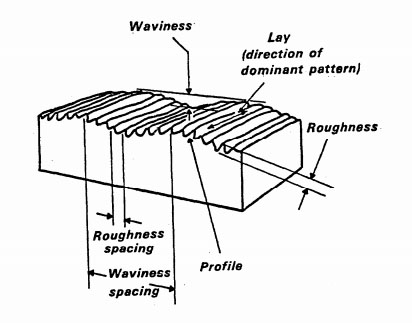
The Relationship of Waviness, Lay, and Roughness…
Lay
The Lay is the direction of the predominant surface pattern and is usually determined by the production method used to process the surface. Here are some typical Lay patterns:
Surface Finish Lay Patterns…
Surface Roughness
Surface roughness is a measure of finely spaced surface irregularities. Surface roughness is usually what machinists refer to when talking about “surface finish.” When talking about all three characteristics, they may use the term “Surface Texture” more properly.
Waviness
Surface Roughness speaks to fine detail imperfections, but there may also be much coarser irregularities. For example, a surface may be warped or deflected from the ideal.
Surface Finish and Product Function
How do product designers decide what surface finishes to require, and how should CNC machinists think about surface finishes?
There are a variety of considerations, and they may even vary for different stages in the manufacture of a particular part. For example, we may have a surface finish requirement on a casting that ensures the finish (think of it as the deviations of the surface of the casting from an ideal) is good enough that the allowance made for extra material that will be machined off in a future step is sufficient. If the casting is too imperfect, the trough of imperfection may be below the expected machined surface of that future step.
Another important consideration is friction. Reducing surface roughness typically reduces friction, which can be critical to reducing wear and increasing the efficiency of sliding parts.
The required surface finishes are very much determined by the function and use of the component. Ship’s propellors start out with fairly high surface finish standards, but in actual use, they erode pretty quickly. Optical and especially components used with X-rays have some of the finest surface finish requirements achievable.
The goal of the designer is to specify surface finishes that are as coarse as possible but will still function within the part’s desired operating parameters. The goal of the machinist is to achieve surface finishes on parts that are as good as those required by the designer but not better as that results in the cheapest-to-manufacture parts. It’s important for the designer and manufacturer to agree on exactly which parameters (Ra, Rz, etc.) are to be used for inspecting and accepting parts. While there are commonly accepted conversions between these, actually using the same parameters for the inspection that the designer used with the design always yields the best results.
Surface Finishes for Various Manufacturing Processes
Surface Finishes vary tremendously by the manufacturing process used to achieve them. A flame-cut plate edge has a radically different surface finish than a ground surface, for example. Choosing a process that’s capable of achieving the desired surface finish is the first step in figuring out how to manufacture a part that requires a particular finish. Sometimes, more than one process must be overlaid to achieve the desired result cost-effectively.
Here’s a chart table showing the relative surface finish roughness of various manufacturing processes:
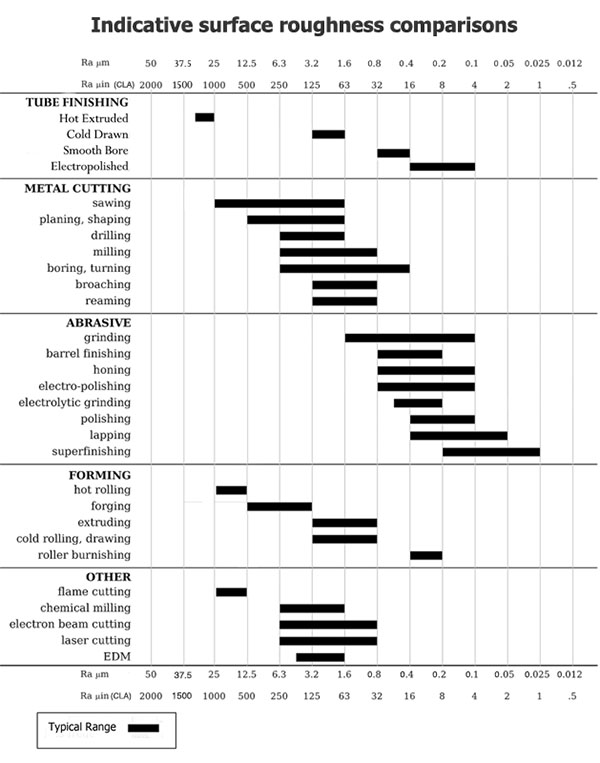
Relative Surface Finish Roughness of Manufacturing Processes…
Measuring and Inspecting Surface Finish
Measurement implies characterizing something as a number–something that’s very important to CNC’ers.
There are a number of different characteristics we might measure with respect to Surface Finish. Two of the most important are the height of the roughness peaks and their separation, often referred to as “Ra” and “D”:

Ra and D are two important surface finish parameters…
The Surface Finish Units we would use for parameters like Ra would be either micro-inches (English or Imperial) or micrometres (Metric). Our chart of surface finishes by manufacturing process (see above) gives both.
When we try to measure a surface finish, the methods fall into three categories:
– Profiling Techniques: Here, a high-resolution probe is used to measure the surface. Think of a sensitivity more in line with a phonograph needle than a typical CNC Probe.
– Area Techniques: With an area technique, a finite area is measured and this provides a statistical average of the peaks and valleys. Examples of area techniques include optical scattering, ultrasonic scattering, and capacitance probes. Area techniques are easier to automate and faster to execute, but profiling techniques are often more accurate.
– Microscopy Techniques: These techniques are usually more qualitative because they rely on measurement of contrast to provide information about peaks and valleys.

Pocket Profilometer…
Surface Finish Units From RA To RZ
Ra – Average Roughness
Ra is also known as Arithmetic Average (AA) or Center Line Average (CLA). It is the average roughness in the area between the roughness profile and its mean line. Graphically, Ra is the area between the roughness profile and its centerline divided by the evaluation length. The evaluation length is normally five sample lengths where each sample length is equal to one cutoff length.
Ra is by far the most commonly used Surface Finish parameter. One reason it is so common is that it is fairly easy to take the absolute value of a signal and integrate the signal using analogue electronics, so Ra could be measured by instruments that contain no digital circuits.
Ra, while common, is not sufficient to completely characterize the roughness of a surface. Depending on the application, surfaces with the same Ra can perform quite differently. Here are 4 surfaces with the same Ra and quite different shapes:

All four surfaces have the same Ra but quite different shapes…
To distinguish these differences, more parameters are needed.
Rmax – Vertical distance from highest peak to lowest valley
Rmax is particularly sensitive to anomalies such as scratches and burrs that may not be obvious from measures such as Ra that rely on averages.
Rz – Preferred by many Europeans
Rz is often preferred to Ra in Europe, particularly Germany. Instead of measuring from the centerline like Ra, Rz measures the average of the 5 largest peak-to-valley differences within five sampling lengths. While Ra is relatively insensitive to a few extremes, Rz is quite sensitive since it is the extremes it is designed to measure.
Surface Roughness Grades: “N” Numbers
Here is a chart table showing how Roughness Grade Numbers convert to Ra numbers:
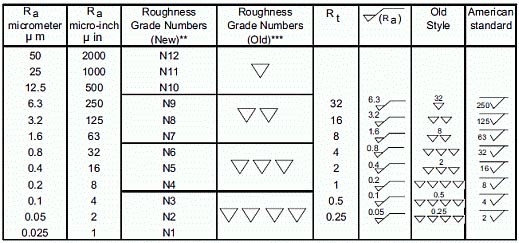
Roughness Grade Numbers and Ra Measures…
Surface Roughness of Abrasive Grits and Sandpaper
One approach to Surface Finish is to use abrasives or sand the surface. This chart converts from abrasive grit to Surface Finish Ra values:

Surface Finish Math and Equations
|
To Calculate
|
Equation
|
Notes
|
| Ra | Ra = CLA = (M1 + M2 + M3 + M4) / 4 |
Where:
M1, M2, … Mn are measure valuesAverage Roughness in micro-meters or micro-inches. Ra is the arithmetic mean deviation of the profileRc
Mean height of profile irregularitiesRku
Kurtosis of the profileRmax
Maximum roughness depthRmr
Material Ration of the profileRpRp = MAX( M1, M2, M3, … )Max profile peak heightRqRq = RMSRoot mean square deviation of the profileRsk
Skewness of the profileRt
Max height of the profileRvRv = MIN( M1, M2, M3, … )Max Profile Valley DepthRy
Max height of the profileRzRz = Ra x 7.2
This is a very ROUGH estimate and not an exact conversion!Avg Max height of the profileRz ISO
Roughness HeightRPM
Average max profile peak heightRMSRMS = SQRT( (M1^2 + M2^2 + M3^2 + M4^2) / 4 )Root Mean Square
CLACLA = RaCenter Line AverageCut-Off Length
Length required for sampleNN = Ra (um) x 40New ISO (Grade) Scale Numbers
Surface Finish Symbols, Callouts, and Standards
In the United States, surface finish is usually specified using the ASME Y14.36M standard. The rest of the world commonly uses International Organization for Standardization (ISO) 1302.
Callouts and symbols used for different surface finishes can be slightly different, so we’ll look at a couple.
ISO Surface Finish Symbols and Callouts


ANSI Surface Finish and Callouts

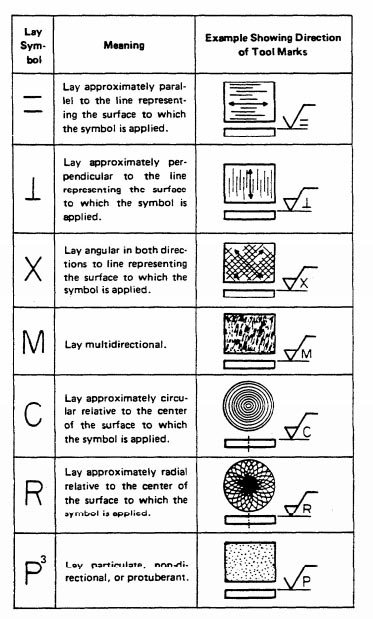
Surface Finish Symbols and Callout Example
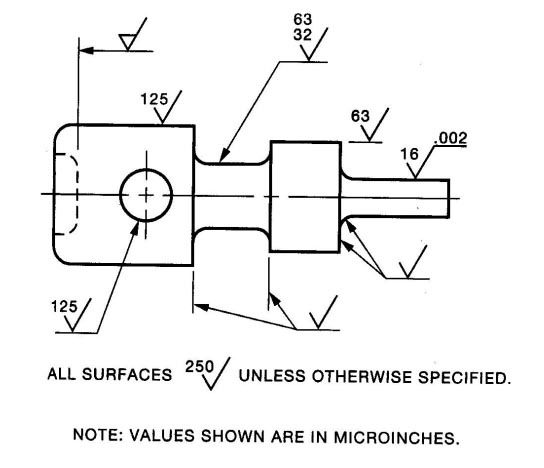
GD&T Surface Finish
Someone will be along soon to finish this section!
Surface Finish Cheat Sheet
A super handy Surface Finish “Cheat Sheet”:
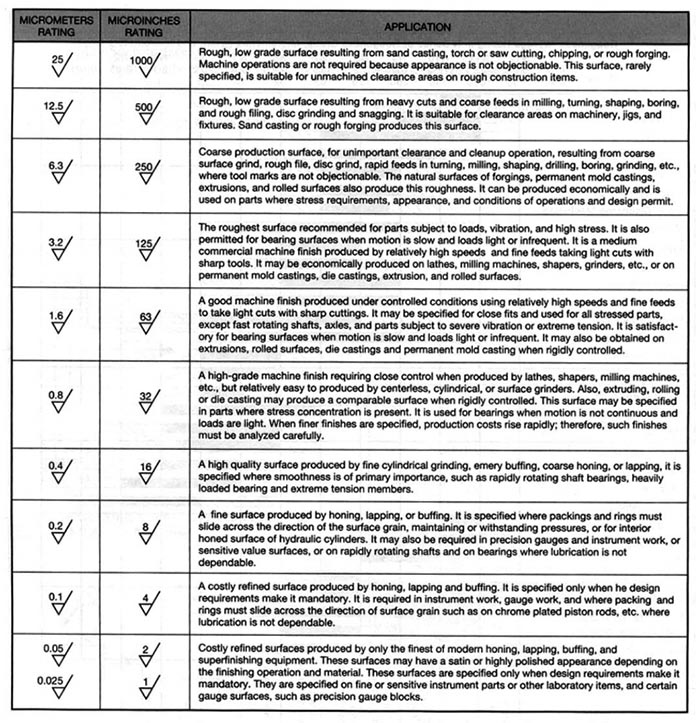
Factors Affecting Surface Finish
There are many factors that affect surface finish, with the biggest being the manufacturing process (see table above). For machining processes, such as milling, turning, and grinding, factors such as cutting tool selection, machine tool condition, toolpath parameters, feeds, speeds, tool deflection, cut width (stepover), cut depth, coolant, and vibration are just a few of the many.
Feeds and Speeds and Surface Finish
In general, adjust feeds and speeds for a lower chipload at the same rpms for a better finish. Take a finish pass that’s relatively light as well. Make sure as you’re doing this to avoid rubbing, which is very hard on tool life.
Our G-Wizard Calculator software has a handy “Tortoise-Hare” slider that makes it easy to dial in proper feeds and speeds for a finishing pass:

G-Wizard’s Tortoise-Hare slider for dialing in your finish…
G-Wizard will also warn you if rubbing is a risk, which will help you avoid that problem.
Ballnose Scallops and 3D Profiling Surface Finish
If you’re 3D Profiling, each pass of the ballnosed cutter leaves a “scallop” in the surface of the material. Our G-Wizard Calculator software has a special Mini-Calc that will help you adjust for a scallop height that delivers the required surface finish:

Ballnose Surface Finish Calculator…
Enter the maximum scallop height and G-Wizard will tell you the resulting RA and RMS surface finish as well as calculate the stepover. BTW, if you want to know how to pick optimal stepovers and tool diameters for 3D Profiling, we’ve got an article on that too!
Surface Finish While Turning
Turning is very similar to 3D profiling in that the stepover, in this case determined by the feedrate while turning, results in scallops that match the shape of the turning insert. We use this to good effect when turning threads, but if we want a smooth shaft, we’ll have a surface finish requirement that must be met. That will determine feedrate and insert nose radius we can use for the job. G-Wizard has a nice calculator for that too:

Surface Finish Turning Calculator…
Surface Roughness Conversion Chart Tables – Metric and Imperial
| Cut-off Length | ||||||
| Ra (µm) | Ra (µinches) | RMS | Rt | N | in | mm |
| 0.025 | 1 | 1.1 | 0.3 | 1 | 0.003 | 0.08 |
| 0.05 | 2 | 2.2 | 0.5 | 2 | 0.01 | 0.25 |
| 0.1 | 4 | 4.4 | 0.8 | 3 | 0.01 | 0.25 |
| 0.2 | 8 | 8.8 | 1.2 | 4 | 0.01 | 0.25 |
| 0.4 | 16 | 17.6 | 2 | 5 | 0.01 | 0.25 |
| 0.8 | 32 | 32.5 | 4 | 6 | 0.03 | 0.8 |
| 1.6 | 63 | 64.3 | 8 | 7 | 0.03 | 0.8 |
| 3.2 | 125 | 137.5 | 13 | 8 | 0.1 | 2.5 |
| 6.3 | 250 | 275 | 25 | 9 | 0.1 | 2.5 |
| 12.5 | 500 | 550 | 50 | 10 | 0.1 | 2.5 |
| 25 | 1000 | 1100 | 100 | 11 | 0.3 | 8 |
| 50 | 2000 | 2200 | 200 | 12 | 0.3 | 8 |
Reference:- http://www.cnccookbook.com/Calculators/SurfaceFinishChartMeasureSymbols.html


Students who searched for dental hygienist schools in illinois found the articles, information, and resources on this page helpful.
[url=http://bobijoel.ml/page/dental-hygienist-salary-florida/]Dental hygienist salary florida[/url]
After examine a couple of of the blog posts in your website now, and I actually like your manner of blogging. I bookmarked it to my bookmark web site listing and will likely be checking back soon. Pls take a look at my web page as nicely and let me know what you think.
This is a splendid read man. Great Share. However I’m having issue with your RSS . Fail to subscribe. So anybody else having similar RSS problem? Anybody who can assist kindly reply. Thanks in advance
Its Pleasure to understand your blog.The above articles is fairly extraordinary, and I extremely enjoyed reading your blog and things that you simply expressed. I really like to appear back on the normal basis,post additional during the topic.Thanks for sharingkeep writing!!!
excellent post, very informative. I ponder why the opposite specialists of this sector don’t realize this.
You should continue your writing. I am sure, you have a huge readers’ base already!
Have you ever considered adding more videos for your blog page posts to keep the readers more entertained? I indicate I just read through the entire post of yours and it was fairly very good but since Im more of a visual learner,I observed that to be more helpful nicely let me understand how it turns out! I enjoy what you guys are always up also. This kind of clever operate and reporting! Keep up the excellent works guys Ive added you guys to my blogroll. This is a great post thanks for sharing this informative information.. I will pay a visit to your blog site regularly for some latest publish.
Excellent post. Keep writing such kind of info on your page.
Im really impressed by your blog.
Hey there, You have done a fantastic job. I’ll definitely digg it and for my part recommend to my friends.
I am confident they will be benefited from this website.
You need to take part in a contest for one of the
finest websites on the internet. I am going to highly
recommend this site!
Saved as a favorite, I like your website!
I constantly spent my half an hour to read this webpage’s posts every day along with a mug of
coffee.
Greetings! Very useful advice in this particular post!
It is the little changes that make the most important changes.
Thanks a lot for sharing!